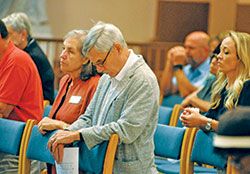Priest abuse victim at holy hour says it ‘was the right thing to do’

Katherine and Norbert Krapf kneel in silent prayer during the “Holy Hour of Prayer, Penance and Healing” in SS. Peter and Paul Cathedral in Indianapolis on Sept. 15. (Photo by Sean Gallagher)
By Natalie Hoefer
The couple looked tired. They had returned from a trip to Germany the prior evening.
But jet lag or not, Norbert and Katherine Krapf were there at SS. Peter and Paul Cathedral in Indianapolis on Sept. 15 for the “Holy Hour of Prayer, Penance and Healing.” They were there not just because they are members of the Cathedral Parish. Nor were they there out of shock at the growing clergy abuse scandal.
“I feel that I need to be here to represent my fellow survivors,” said Norbert.
By “survivors,” he means survivors of priest sexual abuse. The 74-year‑old native of Jasper, Ind., in the Evansville Diocese, was among the scores of Catholic boys abused by his parish priest in the 1950s.
Norbert stifled his emotions and memories for decades. But in 2006 he revealed the abuse of the priest, who died in 1988, to Bishop Gerald A. Gettelfinger, then-bishop of the diocese where the abuse took place. In 2007, the bishop made the priest’s abuse public.
Since then, Norbert has been on a journey of healing through counseling and writing. To cope with his emotions and to help other victims cope with theirs, the 2008-10 Indiana poet laureate has published a book of poetry and a book about his journey of healing. He is nearing completion of a staged production featuring the four voices in his poetry book about the abuse—the boy, the adult, the priest and a mentor called “Mr. Blues.”
“I’ve been writing about this since 2007,” he said. “I’ve written other things, but it [dealing with the effects of the abuse] has been with me for sure.”
Katherine has suffered as well through her husband’s struggles with suppressing and confronting his abuse throughout their nearly 50 years of marriage.
For her, the holy hour was “an intense relief, because I’ve been waiting for some kind of acknowledgment of the crisis from the sanctuary in the church,” she said.
Silence about abuse has negative impacts, as Norbert knows from so many years of suppressing his own emotions.
“You can’t open yourself to healing until you open yourself to the grief,” he explained. “And I think too much of the grief has been shut out and suppressed.
“Survivors who suppress their grief pay the price. The same is true of the community and of the whole Church. And that’s what’s happening now, I think,” he said of the growing accusations of sexual misconduct and abuse by priests, and the bishops who covered up the accusations.
The holy hour proved to be “unadorned and straightforward, a perfect balance of silence and words,” said Katherine, 79.
Part of the time of silence occurred during the exposition of the Blessed Sacrament.
“When I saw the monstrance, and inside it is the body of Christ, I said to myself, ‘My God. Every priest, in abusing a child, was abusing the body of Christ,’ ” Norbert said. “I’ve never seen it quite that directly. That was powerful.”
So, too, was his response to the reading from Ezekiel, in which God proclaims, “I myself will be the shepherd of my sheep” (Ez 34:15).
“A beautiful service like this makes one feel aspects of the [Scripture] not evident before,” Norbert said. “I kept thinking of all the sheep that were ruined …,” he said of both the “injured” sheep in the Scripture passage and the current victims of priest abuse. “I thought of the many survivors I now know, … [and] how the abuse just keeps rippling, the side effects, the consequences.”
But Katherine also noted the other side of those suffering, the “victimization of the good priests,” she said. “When I saw [Archbishop Charles C. Thompson] prostrate I thought, ‘Why does he have to do this?’
“But there was room for all those suffering” from the sexual abuse scandal, she said. “I found myself even praying for the priests who were the abusers,” and “those [victims] who haven’t found their way back to the Church. … How good [the holy hour] could have been for some people who are thinking of never entering a church again.”
One of the most striking moments for Katherine was the singing of the centuries-old Latin hymns O Solutarius Hostia and Tantum Ergo, the traditional musical bookends for adoration of the Blessed Sacrament.
“It was as though it brought me back into that world, into that time period” of the 1950s and 1960s, when much of the abuse occurred, she said. “It’s a beautiful thing that the hymns survive, and that they will continue to be beautiful hymns, and that they give us comfort.”
Though tired from jet lag, the Krapfs
agreed they were gratified by the “Holy Hour of Prayer, Penance and Healing.”
“I was very comforted by the archbishop’s statement that this was simply the beginning of a long process,” said Katherine.
“I want to thank Archbishop Thompson for holding this holy hour,” Norbert added. “It was the right thing to do.” †
Related story: Archbishop Thompson leads holy hour in response to clergy sexual abuse crisis
